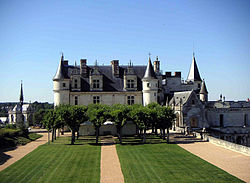Bosquet
In the French formal garden, a bosquet (French, from Italian bosco, "grove, wood") is a formal plantation of trees, at least five of identical species planted as a quincunx, or set in strict regularity as to rank and file, so that the trunks line up as one passes along either face. Symbolic of order in a humanized and tamed Gardens of the French Renaissance and Baroque Garden à la française landscape, the bosquet is an analogue of the orderly orchard, an amenity that has been intimately associated with pleasure gardening from the earliest Persian gardens of the Achaemenids.
Characteristics

Bosquets are traditionally paved with gravel, as the feature predates Budding's invention of the lawnmower, and since the maintenance of turf under trees is demanding (but see the modern bosquet at Amboise, right). The shade of paired bosquets flanking a parterre affords both relief from the sunny glare and the pleasure of surveying sunlit space from shade, another Achemenid invention.

As they mature, the trees of the bosquet form an interlacing canopy overhead, and they are frequently limbed-up to reveal the pattern of identical trunks. Lower trunks may be given a lime wash to a selected height, which emphasizes the pattern. Clipped outer faces of the trees may be pleached.
Within a large wood a bosquet in another, closely related sense can be set out as a formal "room", a cabinet de verdure [1] cut into the formal woodland, a major ingredient of André Le Nôtre's Versailles. These intimate areas defined by clipped walls of shrubs and trees offered privacy and relief from the grand scale and public formality of the terraces and allées. Often a single path with a discreet curve or dogleg provided the only access. Inside the bosquet, privacy was assured; there virtuoso jeux d'eau and sculpture provided allegorical themes: there is a theatre in the Bosquet des Rocailles. The bosquets were altered often during the years Le Nôtre worked at Versailles.
The bosquets of Versailles were examples of a matured tradition. They were preceded by simple squares of regularly planted bosquet alternating checkerboard fashion with open squares centering statues, outlined by linking allées in an illustration of an ideal grand garden plan in André Mollet's Le jardin de plaisir, 1651.[2] In Alexandre Francini's engravings (1614) of the royal gardens at Fontainebleau and Saint Germain-en-Laye, compartments of bosquets are already in evidence. In Jacques Boyceau's posthumous Traité du iardinage selon les raisons de la nature et de l'art (1638), designs for bosquets alternate with patterns for parterres.

In the eighteenth-century, bosquets flanked the Champs-Elysées, Paris. In Paris, bosquets set in gravel may still be enjoyed in the Jardin des Tuileries and the Jardin du Luxembourg.
After a century of naturalistic landscape gardening and two generations of revived pattern planting some bosquets re-entered garden design at the turn of the twentieth century. The garden at Easton Lodge, Essex, designed by Harold Peto inherited what was now called a bosquet but was originally a seventeenth-century garden wilderness, the "curious" English variant of the bosquet: "This ornamental grove or thicket was planted with native tree species approximately 400 years ago and originally included a path network of concentric circles and radiating lines." (ref. Easton Lodge)
Bosquets, unfamiliar in American gardens, but introduced in the Beaux-Arts gardens of Charles A. Platt, were planted along the Fifth Avenue front of the Metropolitan Museum in 1969-70.
Typical trees employed for bosquets are fine-scaled in leaf, such as linden (Tilia cordata), hornbeam (Carpinus) or hazelnut (Corylus).
See also
References
Notes
- ^ "closet of greenery", where cabinet/closet signifies a small intimate chamber. A larger bosquet cut into the woodland might be called a salle at Versailles, such as the Salle des Antiques where twin stone-edged rills punctuated by marble copies of Roman sculptures defined an "island" of parterre, surrounded by a gravel walk, with exedrae cut into the surrounding green walls (ref. "Salle des Antiques")
- ^ Illustrated by Sten Karling, "The importance of André Mollet" fig. 20, in The French Formal Garden, Dumbarton Oaks, 1974.
External links
- Lisa L. Moore, "What gardens mean: Some Eighteenth Century Background"
- Easton Lodge
- Mark Laird, 1992. The Formal Garden: Traditions of Art and Nature (Thames and Hudson, London) Chapter 2: "Baroque Gardens: The Age of Parterre and Bosquet"
- "The Salle des Antiques at Versailles"

